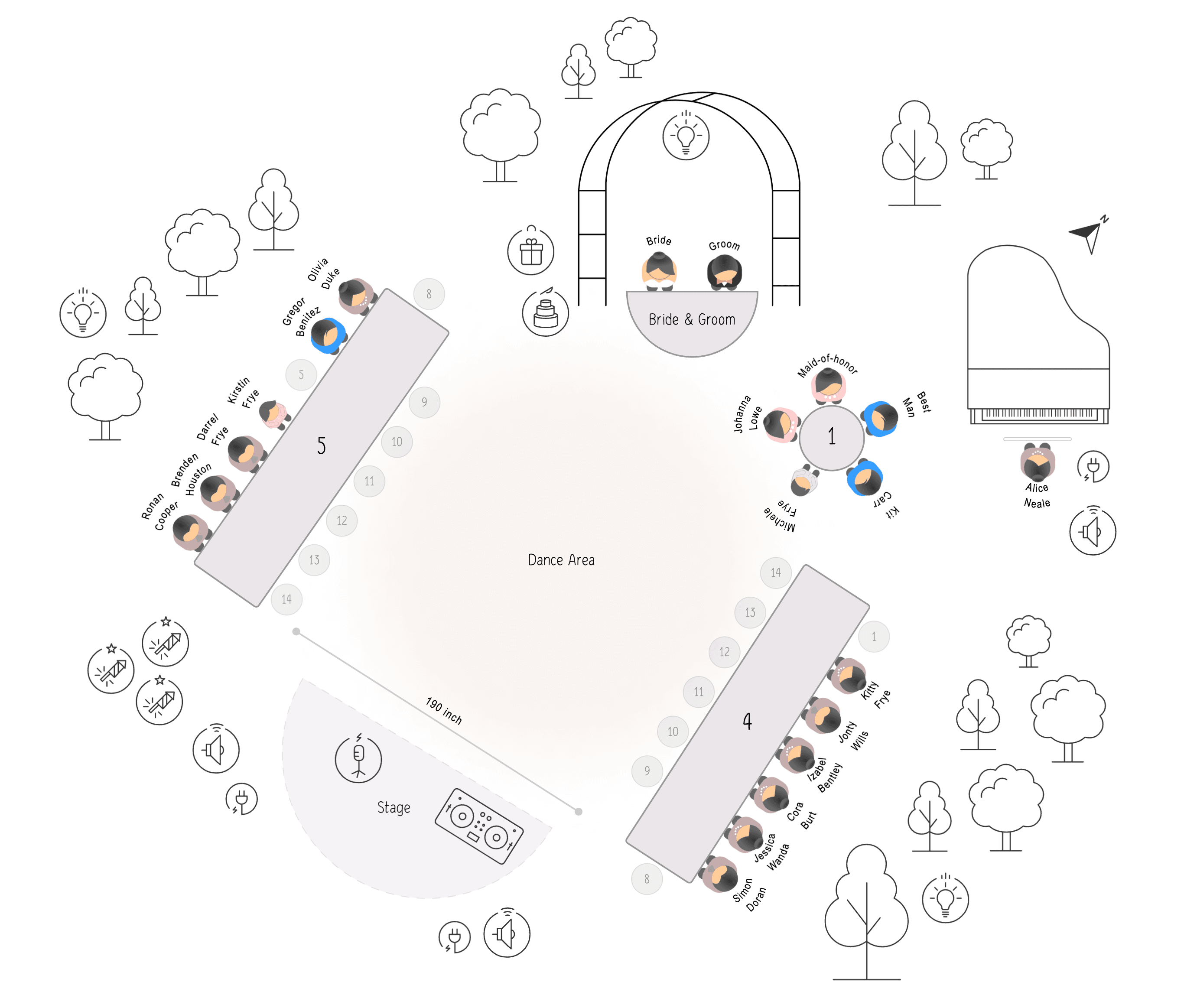Explore more wedding ideas & advice
Wedding
Ceremony Seating Chart
Our service has assisted tens of thousands of couples worldwide in planning their dream weddings!
You may not want to give every guest specific seating for your ceremony, but it pays to plan where the VIPs will be.
If you’re one of those couples who’ve labored over their guest list. Spent many nights carefully placing guests in their optimal positions on your wedding reception seating chart. Then you’d be forgiven for thinking that’s it! No more worrying about where best to sit friends and relations. But, there is one more event that needs to be planned. And it’s quite an important one! Thankfully, though, creating a good wedding ceremony seating chart is a lot easier than planning a reception seating plan.
Whether you’re choosing to stick rigidly to wedding tradition, or would prefer to mix things up. You’ll certainly find that ceremonies almost place themselves. However, it is vital to have some kind of plan in place for your ceremony seating. As it’ll help your guests feel more assured when they arrive. Knowing where they should be sitting, roughly at least.
Create your own seating chart
PLANNING . WEDDING — is easy to remember and even easier to use.
How to Plan Your Wedding Ceremony Seating Chart
We’ll share the traditional way guests should be seated at your ceremony, along with ways to keep your vows feeling fresh.
Elegant ceremony seating chart
Which Side of the Aisle Should Guests Sit on, Traditionally?
The side each group of guests sits on is traditionally determined by their religion. For example, in Christian, heterosexual weddings, the bride’s family and friends sit on the left-hand side, facing the altar. Whereas in Jewish weddings, the formation is reversed, or arranged by gender for more orthodox ceremonies.
Create your seating chart
Where Should Guests Sit at a Traditional Wedding Ceremony?
The general rule for wedding guest seating at ceremonies, is to start with the VIPs and work your way back. Parents, grandparents, close family members and your wedding parties should all be closest to you. If they are not already standing with you at the altar.
The next row should be filled with your next closest family members. Aunts, uncles, cousins etc. Every family is different, of course, and if you don’t have a big group, or you’re actually much closer to your cousins than you are siblings – they may even be a part of your wedding party. Feel free to mix around these first two rows to best suit your unique situation.
This mixing around with traditions certainly applies if you have stepparents and extended families from second, or third marriages. Brides states that “In families with stepparents, the most traditional arrangement is to have the mother, her spouse/partner, and any other close relatives of hers take the first row, while the father and his group take the second row.” But do this only if it feels right to you, and if you are closer to your mother than your father. Otherwise, flip things.
For those fortunate enough to have parents on good terms following a break-up, then sit them both on the front row, broken up by other relatives and their spouses.
Which Guests Should Have Reserved Seating at the Ceremony?
Knowing who to give VIP seating to at the ceremony is key when trying to avoid ruffling any feathers. So far we’ve only mentioned the first two rows, but it’s actually wise to use a wedding ceremony seating chart such as ours, to map out the first 4–5 rows.
These first few rows should be reserved for immediate family such as parents, grandparents etc, and your extended family. This will typically include godparents, uncles, and cousins. The best way to ensure guests feel sure in where they are sitting, and give them a little sentimental boost, is to actually place their name where they should sit.
When Should the Immediate Families Be Seated?
Those immediate family members who are not in your wedding party should be finding their seats just before the ceremony is due to begin. Tradition dictates they should be seated after your non-VIP guests, and they should arrive at their seats in order of closeness to the marrying couple.
This traditional way of seating ceremony guests, rigidly sticking to roles, is not for everyone. But it does give the whole event an added level of importance.
How Many Ushers Does Your Wedding Ceremony Need?
The role of ushers has changed considerably over the years, to the point that at modern weddings they are fairly unnecessary. As female guests these days are capable of finding their seats without a male chaperone. However, again, the tradition can be quite sweet when done right, and actually helps guests find their seats quickly.
For those putting together a small wedding ceremony chart, for 50 or fewer guests. No more than one, maybe two ushers are needed. For 100 guests, you’ll certainly need two people to show people to their seats. For every 50 guests, you should have one usher, just to stop any bottlenecks and avoid too much delay.
There’s no need for the ushers to all be male, contrary to tradition. They just need to be prepared to answer any questions confidently and be able to calmly guide older, and younger guests to their seats. Be that directly, or by offering a general suggestion.
Uncover other relevant topics that are associated with the seating chart
The online Wedding Planning Assistant comprises a comprehensive collection of professional tools designed to assist you in independently organizing your celebration seating chart.










